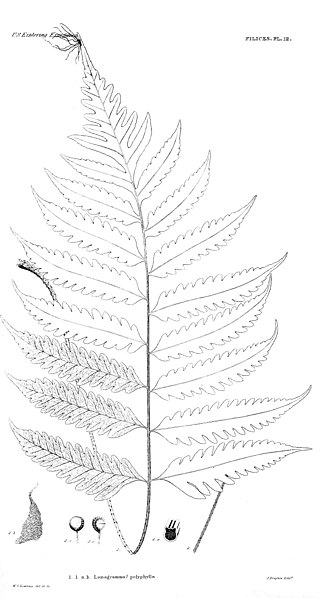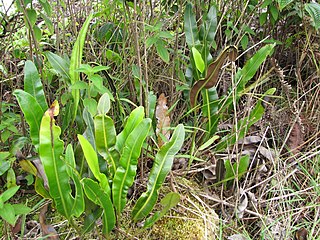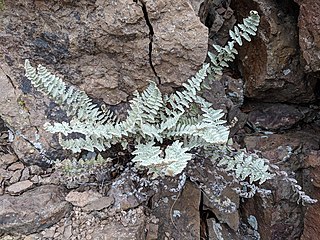
The Dryopteridaceae are a family of leptosporangiate ferns in the order Polypodiales. They are known colloquially as the wood ferns. In the Pteridophyte Phylogeny Group classification of 2016 (PPG I), the family is placed in the suborder Polypodiineae. Alternatively, it may be treated as the subfamily Dryopteridoideae of a very broadly defined family Polypodiaceae sensu lato.

Polypodiaceae is a family of ferns. In the Pteridophyte Phylogeny Group classification of 2016, the family includes around 65 genera and an estimated 1,650 species and is placed in the order Polypodiales, suborder Polypodiineae. A broader circumscription has also been used, in which the family includes other families kept separate in PPG I. Nearly all species are epiphytes, but some are terrestrial.

Microsorum is a genus of ferns in the family Polypodiaceae, subfamily Microsoroideae, according to the Pteridophyte Phylogeny Group classification of 2016 (PPG I). The species are tropical. Like most ferns, they grow from rhizomes, rather than roots. The genus name is often misspelled "Microsorium" or "Microsoreum". It includes some species that are lithophytic rheophytes.
Mickelia nicotianifolia is a species of fern in the family Dryopteridaceae, subfamily Elaphoglossoideae. It has a widespread distribution in Central America and northern South America.

Bolbitis is a genus of ferns in the family Dryopteridaceae, subfamily Elaphoglossoideae, in the Pteridophyte Phylogeny Group classification of 2016.

Lastreopsis, known as shieldfern, is a genus of ferns in the family Dryopteridaceae, subfamily Elaphoglossoideae, in the Pteridophyte Phylogeny Group classification of 2016.

Hypolepis (beadfern) is a genus of ferns described as a genus in 1806. The word is derived from Greek, meaning "under scale". It is found in tropical and subtropical regions, primarily in the New World but also in the Old World and on various oceanic islands.

Diplazium is a genus of ferns that specifically includes the approximately 400 known species of twinsorus ferns. The Greek root is diplazein meaning double: the indusia in this genus lie on both sides of the vein. These ferns were earlier considered part of either the Athyriaceae, Dryopteridaceae, Aspleniaceae, or Polypodiaceae families or recognized as belonging to their own taxonomic family. The Pteridophyte Phylogeny Group classification of 2016 places the genus in the Athyriaceae. The taxonomy of the genus is difficult and poorly known, and by 2009 has never been the subject of a complete monographic study. Their distribution is pantropical, with a few species extending into temperate areas.

Lellingeria is a genus of ferns in the family Polypodiaceae, subfamily Grammitidoideae, according to the Pteridophyte Phylogeny Group classification of 2016 (PPG I).

Plenasium banksiifolium is a fern in the family Osmundaceae. The genus Plenasium is recognized in the Pteridophyte Phylogeny Group classification of 2016 (PPG I); however, some sources place all Plenasium species in a more broadly defined Osmunda, treating this species as Osmunda banksiifolia. It is native along the Pacific coast of Asia, being found in the Kamchatka Peninsula, the Ryukyu Islands, Japan, southeast China, Taiwan, the Philippines, Borneo, Sulawesi and Java. P. banksiifolium, which can reach a height of 1.5 m, is the largest species in the genus and has ornamental value.

Elaphoglossoideae is a subfamily of the fern family Dryopteridaceae. It has previously been regarded as the family Elaphoglossaceae. As circumscribed by the Pteridophyte Phylogeny Group in their 2016 classification, the subfamily excludes the Polybotryoideae, which are kept separate. It can be divided into three clades: the bolbitidoid ferns, genus Pleocnemia, sister clade to the bolbititoids, and the lastreopsid ferns, sister to the combination of the first two clades.
Myriopteris maxoniana is a species of cheilanthoid fern known only from one collection in Tamaulipas, Mexico. It closely resembles Myriopteris longipila and was not described as a distinct taxon until 2004.

Mickelopteris is a genus of ferns in the subfamily Cheilanthoideae of the family Pteridaceae with a single species Mickelopteris cordata. Synonyms include Parahemionitis cordata and Hemionitis cordataRoxb. ex Hook. & Grev. The species is native to south-eastern Asia, from India to Taiwan and the Philippines.

Lomagramma is a genus of ferns in the family Dryopteridaceae, subfamily Elaphoglossoideae, in the Pteridophyte Phylogeny Group classification of 2016.

Parapolystichum is a genus of ferns in the family Dryopteridaceae, subfamily Elaphoglossoideae, in the Pteridophyte Phylogeny Group classification of 2016. The genus is mainly native to the tropics, although its range extends to southeastern Australia.
Megalastrum is a genus of ferns in the family Dryopteridaceae, subfamily Elaphoglossoideae, in the Pteridophyte Phylogeny Group classification of 2016. The genus has around 100 species, mainly found in tropical America and Africa.

Elaphoglossum is a genus of ferns in the family Dryopteridaceae, subfamily Elaphoglossoideae, in the Pteridophyte Phylogeny Group classification of 2016.

Dendroconche is a genus of ferns in the family Polypodiaceae, subfamily Microsoroideae, erected in 2019. As of February 2020, the genus was not accepted by some sources.
Argyrochosma lumholtzii is a rare fern in the family Pteridaceae known from Sonora, Mexico. It is quite similar to Jones' false cloak fern, but has black leaf axes and a less highly divided leaf. First described as a species in 1939, honoring the explorer Carl Sofus Lumholtz, it was transferred to the new genus Argyrochosma in 1987, recognizing their distinctness from the "cloak ferns".

Myriopteris rufa, commonly known as Eaton's lip fern, is a moderately-sized fern of Mexico and the southwestern United States, with outlying populations in Costa Rica and the Appalachian Mountains. One of the cheilanthoid ferns, it was usually classified in the genus Cheilanthes, as Cheilanthes eatonii, until 2013, when the genus Myriopteris was again recognized as separate from Cheilanthes. It typically grows in rocky habitats, most frequently on limestone but also sometimes on basalt or shale.















